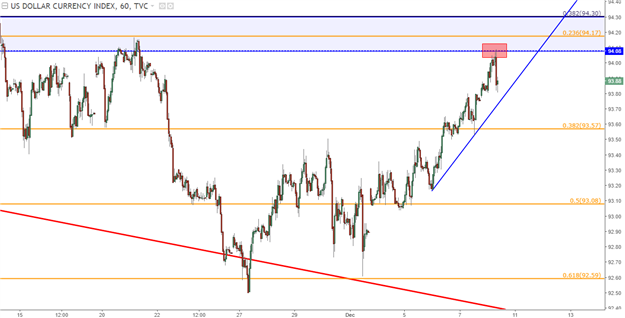Talking Points:
– This morning’s Non-Farm Payrolls showed a +228k print versus the expectation of +195k.
– This brought a quick resistance-check in the U.S. Dollar after which bears began to show-up.
This morning’s Non-Farm Payrolls print out of the United States came-in above expectations, with +228k jobs added to American payrolls in the month of November, and this is a decent beat of the expectation for +195k. This kept the unemployment rate steady at 4.1%, and Average hourly earnings were up .2% in the month versus a .3% expectation. This led to a quick check of the resistance zone that we’ve been following in USD that runs from 94.08-94.30, after which sellers started to take over.
U.S. Dollar via ‘DXY’ Hourly: Rally into NFP, Tag of Resistance Zone and Turn-Lower

Chart prepared by James Stanley
2018 is far from over. With three weeks left on this year’s calendar, many market participants have already started to shift their attention into 2018. But – before we get there, we have a huge week of Central Bank activity when next week brings rate decisions out of the Fed, the ECB, the Bank of England and the Swiss National Bank. The only bank carrying any expectation for any actual moves is the Fed, as markets have kept a near 100% probability of a hike at next week’s meeting. There’s even a growing chorus of those expecting a 50 basis point hike at next week’s meeting, as CME FedWatch is showing a 9.2% probability of such a move.
The U.S. Dollar
The Greenback will likely stay near the center of the fray next week. This is not to say that themes in Europe, the U.K. or even Switzerland are not of importance; but the U.S. Dollar appears to be working on a bigger picture theme and next week’s FOMC meeting can provide some clarity. With next week’s rate hike likely baked-in to current price action, the focus will be on the Fed’s outlook for 2018. Thus far, the Fed has held with their expectation for three hikes in 2018. This puts the bank as somewhat of an outlier amongst large, developed economies; as Central Banks in Europe, the U.K. and Japan continue to embark on uber-dovish policy outlays.













Leave A Comment